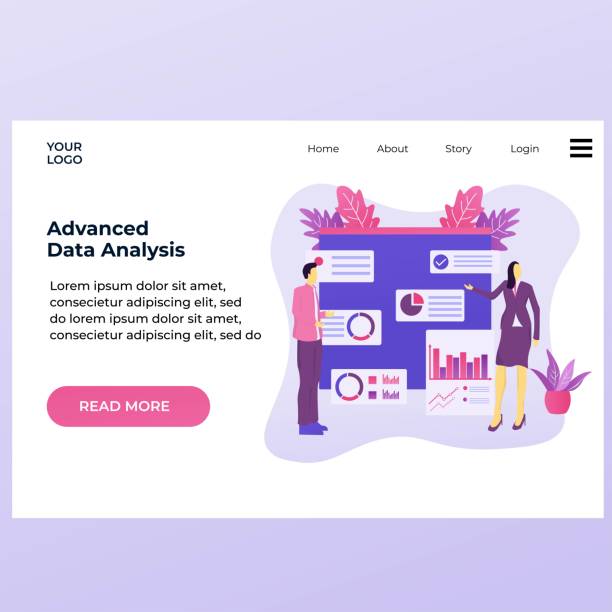Introduction to the World of Multilingual Website Design and its Importance
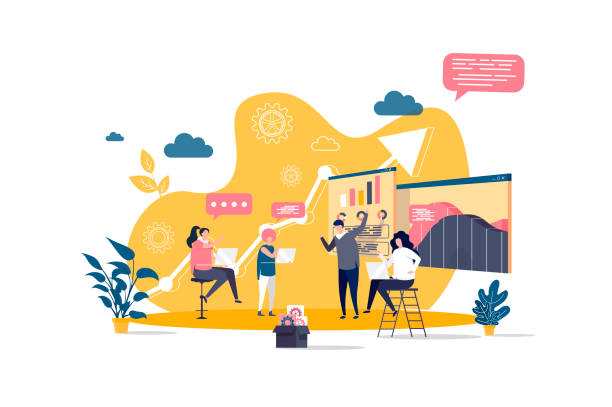
In today’s world, where geographical boundaries have blurred due to the internet, access to a global audience has become more crucial than ever.
#Multilingual_Website_Design is no longer a competitive advantage; it’s a necessity.
This approach allows businesses to convey their message to a global audience in various languages, thereby significantly expanding their target market.
Imagine having a website accessible only in Persian; in that case, you’d miss out on a vast segment of internet users who speak other languages.
This not only means losing potential customers but can also leave your brand unknown on a global scale.
A multilingual website is a gateway to new opportunities in international markets.
It’s a strategic investment for the future of any business that dreams of going global.
Multilingual website design goes beyond mere content translation; this process involves full localization of the user experience (UX) for different cultures and languages, so that users, no matter where they are in the world, feel comfortable and a sense of belonging.
Many companies are still unaware of the true importance and hidden potential in designing and launching a multilingual site.
This oversight can lead to falling behind in intense global competition.
Did you know that most internet searches worldwide are not in English? This is a crucial fact indicating that by providing content in only one language, you deprive yourself of billions of potential users.
The guidance provided in this article will help you approach this topic with a specialized and educational perspective.
It also addresses the analytical aspects and challenges ahead in this path.
Proper implementation of a multilingual website can significantly increase your organic traffic, improve conversion rates, and enhance your brand’s credibility internationally.
This is particularly vital for exporting companies or businesses aiming to sell products and services to users worldwide.
Does your current website convert visitors into customers or drive them away? Solve this problem forever with professional corporate website design by Rasaweb!
✅ Build powerful credibility and branding
✅ Attract target customers and increase sales
⚡ Get a free consultation now!
Competitive Advantages of a Multilingual Website for Businesses

Having a #multilingual_website gives your business significant competitive advantages, which are crucial in today’s saturated market.
First and foremost, it provides access to new markets and increases market share.
When your products or services are available in the native language of potential customers, they feel a stronger connection with your brand, and this directly impacts conversion rates.
Studies have shown that users prefer to buy from websites whose content is in their own language, even if they are proficient in another language.
This is a specialized and vital point in digital marketing.
Secondly, Multi-language SEO helps you achieve higher rankings in search results for various keywords in multiple languages.
By using hreflang tags and correct keyword localization strategies, you can ensure that search engines display the correct version of your site to users in different geographical regions.
This not only increases your organic traffic but also directs more targeted traffic towards you.
This part of the discussion is highly educational and contains technical details.
Third, a multilingual website enhances your brand’s credibility globally.
It demonstrates your professionalism and commitment to serving customers worldwide.
This is particularly important for large corporations or startups looking to attract international investment.
Financial benefits and brand reputation are among the direct results of multilingual website design that cannot be overlooked.
This is a smart strategy for sustainable growth in the digital world.
Challenges and Solutions in Multilingual Website Design

Although #multilingual_website_design offers numerous benefits, it also comes with its own challenges that must be addressed for success.
One of the biggest challenges is content and translation management.
Maintaining consistency, quality, and updating content in multiple languages can be very complex.
The solution to this issue is to use advanced Content Management Systems (CMS) that fully support multilingual capabilities, such as WordPress with plugins like WPML or more specialized platforms like Sitecore.
These systems allow you to centrally manage content and simplify the translation process.
This section includes guidance and specialized tips.
The second challenge is multilingual SEO, which is a complex topic in itself.
Hreflang tags must be implemented correctly for search engines to present the right pages to the right users.
Also, each language requires its own specific keyword research, as popular keywords in one language might differ or even have no meaning in another language.
The solution here is to seek help from SEO experts experienced in multilingual contexts and use localization tools.
Multilingual website design requires extreme precision.
The third challenge is the technical aspect of the infrastructure.
Choosing the appropriate URL structure (subdomain, subfolder, or top-level domains) for each language, hosting, and page loading speed in different regions of the world all impact user experience and SEO.
For this purpose, it is recommended to collaborate with a web development team experienced in building multilingual websites.
Below is a comparative table of common URL structuring methods for multilingual sites:
| Method | URL Example | Advantages | Disadvantages |
|---|---|---|---|
| Country Code Top-Level Domains (ccTLDs) | example.de, example.fr | Strong local SEO, clear geographical separation | High cost, need for managing multiple domains, backlink complexity |
| Subdomains | de.example.com, fr.example.com | Easier implementation, central management of main domain, relatively good SEO | Some SEO complexities (Google sees them as separate sites) |
| Subdirectories | example.com/de/, example.com/fr/ | Strong SEO (all link equity goes to one domain), easier management | Requires appropriate CMS infrastructure, less obvious to the user at first glance |
Choosing the right method depends on your business goals, budget, and technical resources.
Choosing the Right Platform and Technology for Multilingual Website Development
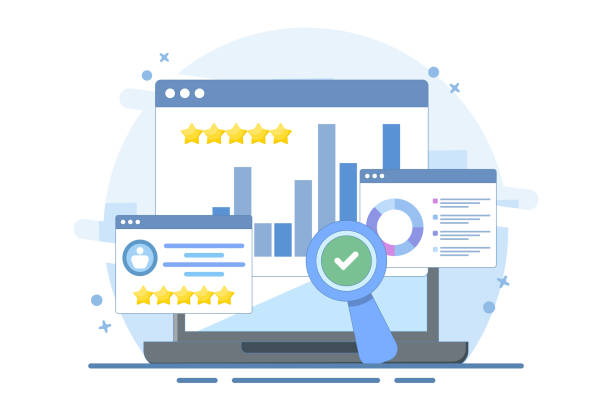
One of the key decisions in #multilingual_website_design_and_development is choosing the right platform and technology.
This choice will directly impact ease of management, scalability, and project cost.
Popular Content Management Systems (CMS) like WordPress, with specialized multilingual plugins such as WPML or Polylang, are good options for small and medium-sized businesses.
These plugins allow for translating content, categories, tags, and even menus, simplifying the multilingual website design process.
However, it should be noted that adding too many plugins might affect site performance and speed.
For larger and more complex projects with broader localization needs, enterprise platforms like Drupal or more specialized tools such as Sitecore or Adobe Experience Manager (AEM) can offer more robust solutions.
These platforms typically have deeper localization capabilities and allow for managing translation workflows, A/B testing for localized content, and personalizing the user experience based on geographical region.
Choosing the appropriate platform depends on your budget, content volume, technical requirements, and desired level of control.
This is a specialized decision that should be made carefully and in consultation with web experts.
In addition to CMS, using Translation Management Systems (TMS) can make the content translation and update process much more efficient.
These tools can connect to your CMS and allow translation teams to work centrally using Translation Memories (TM) and Termbases, which significantly helps maintain consistency in terminology and reduce translation costs.
Considering these points in the planning phase for designing a site with multi-language support is crucial.
Are you tired of your e-commerce site getting visitors but no sales? Rasaweb solves your core problem with professional e-commerce website design!
✅ Significant sales increase with targeted design
✅ Flawless user experience for your customers
⚡ Get a free consultation!
Multilingual SEO: Challenges and Solutions

Multilingual SEO is one of the most important yet complex aspects of #multilingual_website_design.
The goal is to ensure that search engines provide the appropriate content in the correct language and geographical region to users.
The main challenge here is to prevent duplicate content and ensure proper crawling and indexing of all language versions of the site.
Correct use of the hreflang tag is crucial.
This tag tells search engines which version of a page is suitable for which language and geographical region.
Incorrect implementation of this tag can lead to serious SEO problems.
This section requires specialized understanding and educational precision.
Another important point is keyword research for each language.
Words that are popular in one language might have a different meaning or not be used at all in another language.
For instance, a highly searched keyword in Persian might have a low search volume for its direct translation in English or Arabic.
Therefore, conducting separate keyword research for each target language and culture is essential.
This research should include examining local idioms and common search phrases.
Also, the URL structure for each language is important.
As mentioned in previous sections, choosing between subfolders (example.com/en/), subdomains (en.example.com), or top-level domains (example.co.uk) can affect local and global SEO.
Each method has its pros and cons and should be chosen based on the business’s strategic goals and available resources.
Furthermore, content marketing in each language must also be conducted with consideration for the culture and interests of the local audience.
Simply translated content might not be as engaging as the original version.
This is where the creation of localized content, or even entirely new content for each language, becomes important.
This approach helps you not only achieve better SEO rankings but also increase user engagement.
Multilingual website design without a strong SEO strategy will be incomplete.
Content Management and Translation Processes in Multilingual Websites
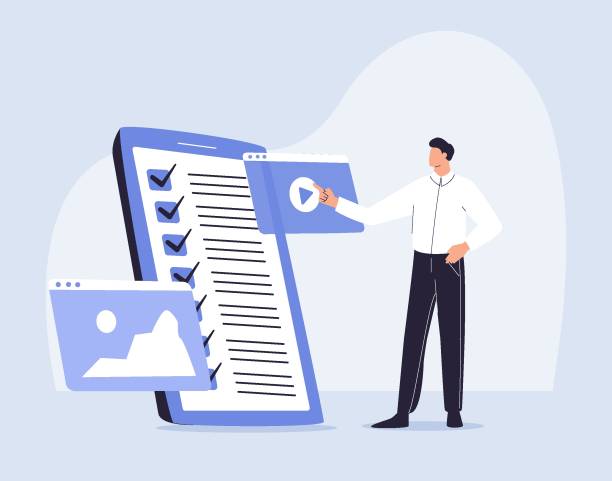
Efficient content management and translation processes are the heart of success in #multilingual_website_design.
Without a clear strategy and appropriate tools, translating and updating content in multiple languages can become a nightmare.
The first step is to create a clear workflow for translation.
This workflow should include stages of content collection, submission for translation, review and editing, and finally publication.
Using a Translation Management System (TMS) or online collaboration tools can automate and simplify this process.
This section is both explanatory and educational.
The importance of selecting professional translators and localizers who are not only proficient in the language but also familiar with the culture and subtle linguistic differences is crucial.
Mere word-for-word translation is not enough; content must be localized to align with the values, idioms, and cultural sensitivities of the target audience.
This includes adapting units (currency, temperature, measurements), date and time formats, and even colors and images.
For example, the color red symbolizes love in some cultures, while in others it signifies danger.
These aspects provide specialized and engaging content for the reader.
Furthermore, maintaining Translation Memories (TM) and Termbases is vital to ensure consistency in translation and reduce costs in the long run.
TMs store previously translated sentences or phrases, eliminating the need to re-translate them.
A Termbase also contains a list of key terms and their approved translations.
These tools not only expedite the translation process but also help maintain integrity and quality across all languages.
Designing and implementing a successful multilingual site requires a robust content management strategy that is considered from the outset.
The Importance of User Experience (UX) in Multilingual Website Design

User Experience (UX) is one of the most important factors in the success of any website, and its importance is amplified in #multilingual_sites.
A poor user experience can quickly drive users away from your site, even if your content is in their native language.
The first point in multilingual UX is the language switcher, which should be easily and intuitively accessible.
This switcher is typically located in the website’s header or footer and indicated by recognizable symbols (such as a flag or language code).
This is a guidance and very important tip for users.
In addition to language switching, attention must also be paid to cultural and localization aspects.
This includes text direction (e.g., right-to-left for Persian and Arabic), date and time formats, currency and measurement units, and even cultural differences in visual design and color usage.
For example, a color that has a positive meaning in one culture might be perceived negatively in another.
This attention to detail customizes the user experience for local audiences and increases brand trust and connection.
This section contains explanatory and somewhat entertaining content.
Site loading speed is also crucial for user experience.
In multilingual website design, it must be ensured that your servers are located near the target audience (using CDN – Content Delivery Network) and that images and other files are optimized for each region.
Loading delays can seriously harm UX.
Trial and error and collecting feedback from real users in different regions are essential for continuous improvement of user experience.
Ultimately, proper UX will lead to higher traffic, better conversion rates, and increased customer loyalty.
Here is a table comparing important UX elements in multilingual platforms:
| UX Element | Importance in Multilingual Site | Localization Example |
|---|---|---|
| Language Switcher Placement | Very High – Easy and visual access | Website header (top right or left), navigation menu, footer |
| Text Direction (RTL/LTR) | Crucial – for readability of languages like Persian, Arabic | Using CSS direction: rtl; for entire content and element layout |
| Date and Time Formats | Medium – for correct information understanding | “YYYY/MM/DD” in some regions, “MM/DD/YYYY” in others |
| Units of Measurement and Currency | High – for usability in e-commerce | Centimeters/Inches, Kilograms/Pounds, Rial/Dollar |
| Images and Icons | High – to avoid cultural misinterpretations | Using more generic or localized images, avoiding culturally specific symbols |
These small but important considerations make a big difference in the user’s perception.
Ongoing Maintenance and Updates for Multilingual Websites

Launching a #multilingual_website is just the first step.
Its ongoing maintenance and updates are crucial for preserving its efficiency, security, and connection with global audiences.
One of the most important aspects of maintenance is content updates across all languages.
Whenever new content is added in the original language, it must be quickly translated and published in all other languages to ensure information remains current for all users.
Failure to update simultaneously can lead to incorrect or outdated information in some language versions, which harms the site’s credibility.
This is a key guidance point.
In addition to content, technical maintenance of the website is also important.
This includes updating the CMS platform, plugins, and themes, monitoring server performance, and site loading speed in different regions of the world.
Technical issues can lead to loss of search engine rankings and poor user experience.
Ensuring website security is also a priority, as cyberattacks can jeopardize user data and harm brand reputation.
These aspects require specialized and regular reviews.
Another important topic is multilingual SEO monitoring.
Continuous monitoring of keyword rankings, organic traffic from different regions, and the performance of hreflang tags is essential to identify and resolve potential issues.
This process should be carried out periodically, and its analytical reports should be reviewed.
A multilingual website design that is properly maintained will become a valuable asset for your business.
Furthermore, monitoring news related to changes in Google’s algorithms and other search engines for multilingual SEO provides important news for technical and SEO teams to adjust their strategies based on the latest developments.
This ensures that your site always remains at its peak performance and fully benefits from the web localization process.
Does your current website display your brand’s credibility as it should? Or does it drive away potential customers?
Rasaweb, with years of experience in professional corporate website design, is your comprehensive solution.
✅ A modern, beautiful website tailored to your brand identity
✅ Significant increase in lead generation and new customer acquisition
⚡ Contact Rasaweb now for a free corporate website design consultation!
Case Study of Successes in Multilingual Website Design
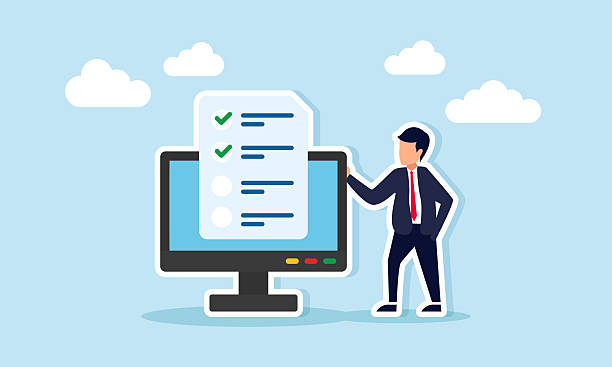
To better understand the potential of #multilingual_website_design, looking at successful examples can be inspiring.
Major companies like Apple and Airbnb are pioneers in this field, having penetrated global markets by implementing powerful multilingual strategies.
Apple’s website is available in dozens of languages and not only translates content but also localizes pricing, marketing campaigns, and even product images based on geographical region.
This is an analytical and comprehensive approach.
Airbnb is another example that has gained the trust of users worldwide by providing its platform in various languages.
They have understood that users care not only about language but also about culture and how to interact on a platform.
This includes multi-language customer support, offering local payment options, and displaying local currencies and units of measurement.
These factors have helped increase conversion rates and customer loyalty worldwide.
This section includes news-related and entertaining content for readers.
These companies demonstrate that multilingual website design goes beyond translation.
It’s an investment in complete customer experience localization.
They enable users to interact with the brand and products in a way that feels natural and comfortable for them.
These successes are the result of meticulous research, strategic planning, and a commitment to quality implementation.
The lessons learned from these examples are invaluable for any business looking to expand globally.
These cases showcase the true potential of multi-language supported website design and how focusing on the needs of international users can lead to great success.
The Future of Multilingual Website Design: AI and Beyond
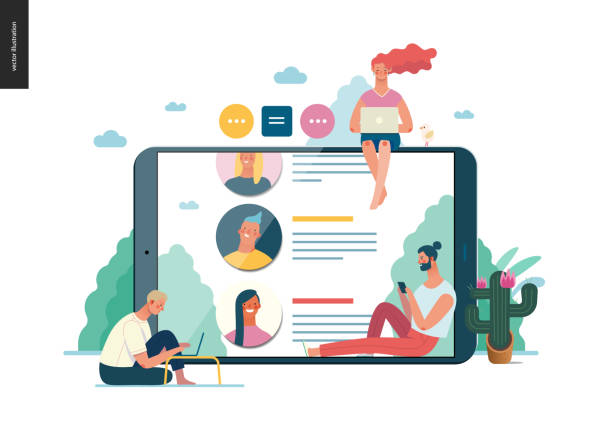
The future of #multilingual_website_design is intertwined with significant advancements in #Artificial_Intelligence and machine learning.
AI has the potential to transform how content is managed and translated.
Neural Machine Translation (NMT) tools have become increasingly accurate and can provide high-quality translations in a short time.
This can significantly reduce the costs and time required for localization.
However, even with AI advancements, the role of human review and cultural localization remains essential to ensure that the content is not only linguistically correct but also culturally appropriate.
This section provides analytical and thought-provoking content.
Another future trend is advanced personalization based on language, location, and user behavior.
Leveraging big data and AI algorithms, websites will be able to dynamically localize content and user experience in real-time for each user.
This means displaying products, offers, and relevant content based on the specific preferences and needs of each region.
This level of personalization significantly increases user engagement and improves conversion rates.
Multilingual website design will be highly dynamic and interactive in the future.
Emerging technologies like Augmented Reality (AR) and Virtual Reality (VR) may also play a significant role in the multilingual experience in the future, especially in industries such as tourism or education.
Imagine virtual tours of historical sites with automatic audio and text descriptions in various languages.
These examples represent an exciting vision for the future of multilingual website design, which will go beyond traditional frameworks and elevate the user experience to a new level.
In conjunction with AI, multilingual websites will become more powerful tools for global communication.
Frequently Asked Questions
| Question | Answer |
|---|---|
| What is a multilingual site? | A site whose content is available to users in more than one language. |
| Why should I make my site multilingual? | To reach a larger audience in global markets, improve user experience, and enhance international SEO. |
| What are the technical approaches to building a multilingual site? | Using subdirectories, subdomains, or URL parameters to differentiate languages. |
| How does multilingual design affect SEO? | By targeting local keywords and providing content in users’ native languages, the site’s ranking in search engines for those regions improves. |
| What are the challenges of multilingual website design? | Content translation management, supporting right-to-left (RTL) direction, technical issues related to language addressing, and maintaining design consistency. |
| How to choose languages for a multilingual site? | Based on target audience analysis, desired markets, and current site traffic data (if available). |
| What is RTL support and why is it important for some languages? | Right-to-Left is the text and page element display direction from right to left, which is essential for languages like Persian, Arabic, and Hebrew. |
| How to manage multilingual site content? | Using Content Management Systems (CMS) with multilingual capabilities, translation plugins, or professional translation services. |
| What about User Experience (UX) in a multilingual site? | The ability to switch languages must be easily accessible, and translated content must be of high quality for users to feel comfortable. |
| What are common CMS platforms for multilingual sites? | WordPress (with plugins like WPML), Joomla, Drupal, and Shopify (with relevant settings or plugins). |
And other services of Rasaweb Advertising Agency in the field of advertising
Tips for Choosing Ad Size for Display on Industrial Websites
How to Simplify Ads for Beginner Audiences?
Using Big Data to Improve Home Appliance Ads
Ways to Increase Conversion Rates in Home Appliance Ads
How to Use Music in Home Appliance Ads?
And over hundreds of other services in internet advertising, advertising consultation, and organizational solutions
Internet Advertising | Advertising Strategy | Advertorials
🚀 Transform your business’s digital presence with Rasaweb’s internet advertising strategies and advertorials.
📍 Tehran, Mirdamad Street, Next to Central Bank, Southern Kazeroun Alley, Ramin Alley, No. 6

